I actually got a bit ahead of myself with that last post about our mini- cruise, and left out a whole week of doings in Palermo
Time to go back and catch up!
Our week in Palermo can basically be divided into the following segments:
Eating, drinking and related activities, guided walking tours and unguided strolls (both of which tended to merge into the first listed), and finally one or two specific, focused tourist visits where you pay money to go in – well one actually.
We got off to a good start with the guided walks, knocking two off in the first day.
The morning one was basically the monumental one which took us around to the majority of the must see sights and gave us the historical background to the city and its impressive array of structures dating over an impressive range of historical time periods. Most of this has now disappeared into whatever recesses of my mind these things go, but there were a few stand out features which have remained.
First of these was the Cathedral.
 Lonely Planet’s take on the edifice is as follows:
Lonely Planet’s take on the edifice is as follows:
A feast of geometric patterns, ziggurat crenellations, maiolica cupolas and blind arches, Palermo’s cathedral has suffered aesthetically from multiple reworkings over the centuries, but remains a prime example of Sicily’s unique Arab-Norman architectural style. 
I’d say amen to that but add that while it might look a little weird it is also testimony to the apparently peaceful coexistence of people of different origins and religions (Muslim, Byzantine, Latin, Jewish, Lombard and French) through a long period of time, coupled with respect for the culture (and architecture)
The next one I remember is the Massimo Theatre or Opera House.
At the time of its construction in 1897 it was the third biggest in Europe behind Vienna and Milan.  However it has most likely beaten these two for the time taken in renovation in the next century. In 1974 the theatre was closed for reconstruction works that were supposed to be finished in a relatively short time. It remained closed for 23 years!
However it has most likely beaten these two for the time taken in renovation in the next century. In 1974 the theatre was closed for reconstruction works that were supposed to be finished in a relatively short time. It remained closed for 23 years!
Mostly though I was impressed with the Quattro Canti or Four Corners in the heart of the old city. I’ve heard stories about some city in North America that has an intersection with a Starbucks on every corner. God help them if it’s true but this Quattro Canti really does exist and is amazing, even with the traffic still blasting through it! The square formed at the intersection of two major roads is framed by a perfect circle of curved facades that disappear up to the blue vault of the sky in a great display of perspective. Each facade lights up in turn throughout the course of the day, landing it the nickname Il Teatro del Sole (Theatre of the Sun).
The square formed at the intersection of two major roads is framed by a perfect circle of curved facades that disappear up to the blue vault of the sky in a great display of perspective. Each facade lights up in turn throughout the course of the day, landing it the nickname Il Teatro del Sole (Theatre of the Sun).
It is really difficult to get the sense of all four at once, but just imagine this one more or less replicated at each corner and you’ll get the idea.
Each corner is divided in three classical orders: Doric at the bottom, Ionic in the middle and Corinthian at the top. Statues adorn each of the three tiers, representing the seasons at the bottom, Spanish sovereigns in the middle, and female Palermitan saints at the top.
And to finish it off, both sides of the buildings on each corner stretch off into the distance providing eight magnificent baroque street facades. Of course they are no longer palaces but those that aren’t churches are divvied up into a myriad of shops and apartments – amongst which we were directed by our guide to the Pasticerria Costa for the best pastries in town.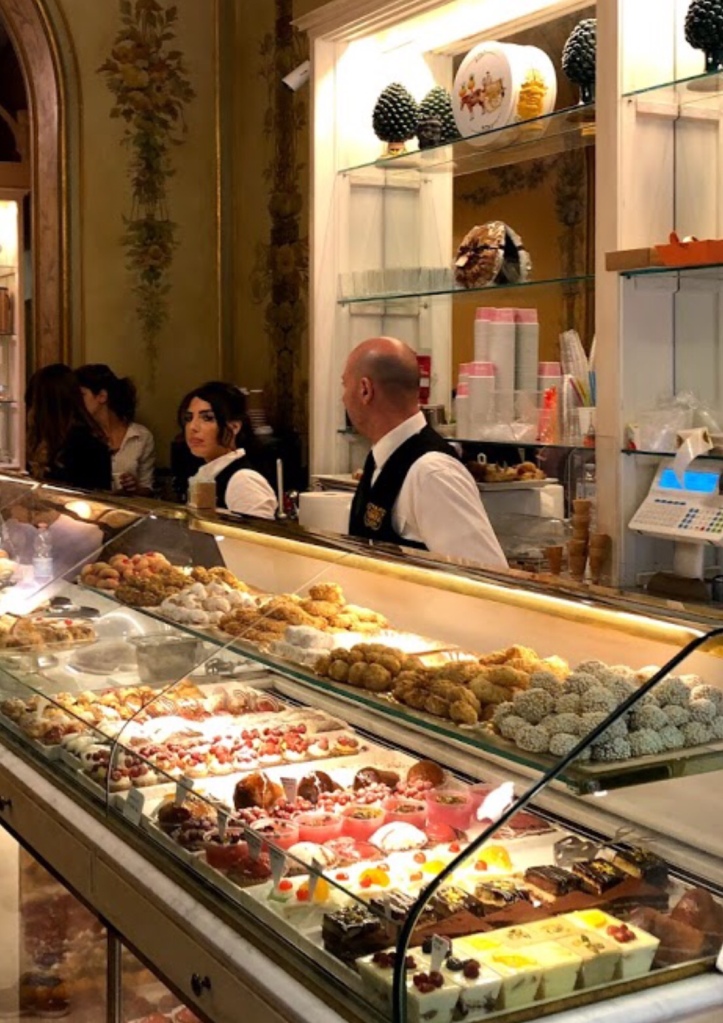
Of course we returned later to sample – too busy stuffing yet another cannoli in my mouth to take a photo, but did get these beauties in the window
What? You might ask…. Fruit and veg in the pasticceria? Well it’s not actually. They are Frutta Martorana, sweet marzipan treats, a speciality of Palermo, available year round but starting to peak now around All Saints/All Souls Day.
Frutta martorana are traditional marzipan sweets in the form of fruits and vegetables made with almond flour and vanilla. Nuns were the first to prepare this dessert when they decorated empty fruit trees with marzipan fruit in an effort to impress an archbishop visiting on November 1, the Day of the Dead, or All Souls Day.
My go to expert on all things Sicilian, lays it all out beautifully in this blogpost
https://siciliangodmother.com/2013/10/30/what-do-dead-people-eat/
Really worth reading.
So that’s about it for the morning walk!
Our evening walk plunged us into the “other” real life Palermo as lived by locals. Turns out we are actually living in the heart of this, the old Arab district ourselves, but nevertheless we picked up some bits I’m sure we would have missed on our own.
One of them was the back story to this very run down rather squalid graffiti covered square. Turns out the graffiti is the visual protest of an Austrian artist who was horrified at the way municipal, provincial and state authorities are allowing the disintegration of historic buildings like this which suffered extensive damage during WW2 bombings (circa 1942) What I thought was just graffiti
What I thought was just graffiti 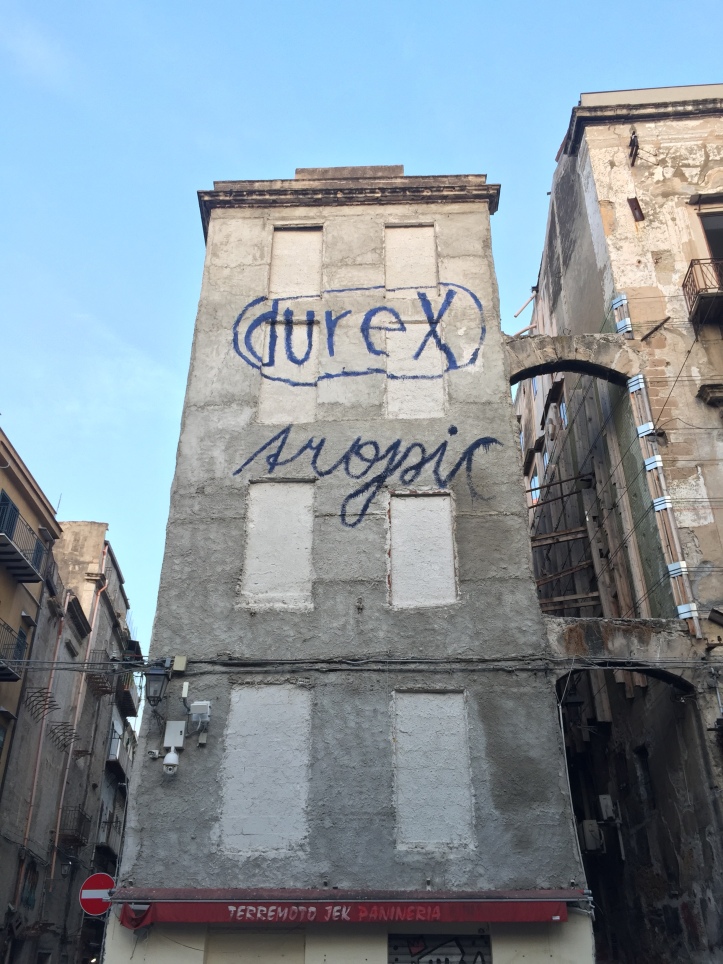 is his very succinct protest statement about the need for protection for these buildings
is his very succinct protest statement about the need for protection for these buildings
Talk about the war and bombings also brought up the role of the Mafia in facilitating the invasion/liberation of Italy which started in Sicily. Apparently the Mafia had no truck with Mussolini and the fascists, but the extent and nature of their assistance to the Allies is still being debated.
What is clear however is the Mafia resurgence in the post war years and the consequences to those who sought to break their power and bring the leaders to justice. I had vaguely heard of Falcone and Borsalino, but got to understand a little more during our week in Palermo. We had previously seen this blown up photo on a wall down at the port not far from our home base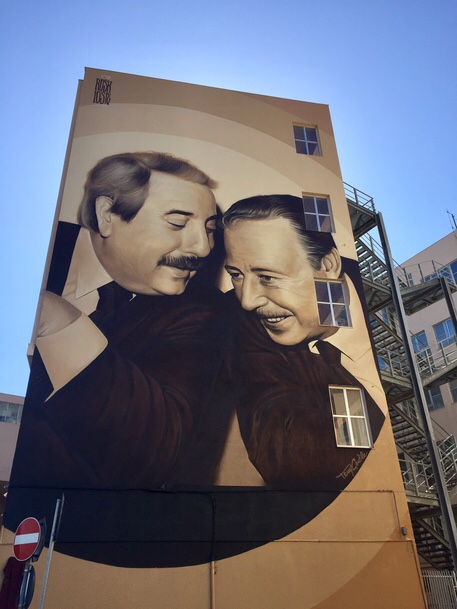 but didn’t know who they were until we went past on our guided walk. We later noticed streets named after them and a memorial plaque at the site of the house where Falcone grew up (bombed during the war – now just an open space with the house foundations remaining)
but didn’t know who they were until we went past on our guided walk. We later noticed streets named after them and a memorial plaque at the site of the house where Falcone grew up (bombed during the war – now just an open space with the house foundations remaining)
Their lives had eerie parallels – childhood friends who grew up in the same area, both went to law school and became magistrates, murdered by the Mafia within weeks of each other.
We also discovered on our evening walk that the connection between the Mafia and the US goes way way back in time. We were shown this plaque in a park very close to where we were staying 
Long story here;
short wiki version as follows:
Joseph Petrosino (born Giuseppe Petrosino, Italian: August 30, 1860 – March 12, 1909) was a New York City police officer who was a pioneer in the fight against organized crime. Crime fighting techniques that Petrosino pioneered are still practiced by law enforcement agencies.
 as well as the largest fig tree in Europe (yep that’s Andy at the bottom)
as well as the largest fig tree in Europe (yep that’s Andy at the bottom)
The Black Hand mob from the US were suspected of having a hand in the operation (sorry!) as indicated in this other little memorial in the park.  and I have just discovered, we had dinner on our last night in the same restaurant as he did shortly before he was murdered.
and I have just discovered, we had dinner on our last night in the same restaurant as he did shortly before he was murdered.
 although there seems to have been a name change since then.
although there seems to have been a name change since then.
Well that pretty much sums up our guided walks.
The one thing we did follow up on our own was the Museum of the Spanish Inquisition, housed in the building where the prisoners were kept and the Inquisitors went about their dreadful business. Oddly enough it fronts the same square where Petrosino was murdered. The building is beautiful, part of the former Ducal Palace of a French aristocratic family from Clermont Ferrand. But what went on inside is less so.

When the Sicilians finally rebelled against the Inquisition which was imposed on them by the Spanish rulers , the lovely Ferdinand and Isabelle, the Spaniards destroyed all the instruments of torture and associated records. They also plastered over the walls of the cells but this didn’t actually erase the unique records painted on to those walls by the prisoners.
They weren’t depictions of the torture or the dreadful conditions under which they were kept. Rather they were representations of Christ – his life and death, biblical stories, saints, martyrs, hell …. religious themes seemingly without exception.



A 2006 article by The Guardian conveys the excitement of discovery as the University of Palermo in the course of restoration work to the palace starts to uncover this amazing pictorial record. At the same time it speculates about what these paintings might mean.
In 2019 when we do this tour the theories seem to have taken more solid shape. They are now along the lines that the paintings were encouraged if not actually forced upon the prisoners as a subtle form of torture of Islamic and Jewish prisoners for whom the depiction of the human form was totally at odds with their entire belief system.
At the same time apparently, all prisoners were trying to show through their paintings their deep knowledge and understanding of theology and everything underpinning the Holy Catholic Church (especially as it pertained to Spain – this was after all the Spanish Inquisition, not the Roman one) and thus demonstrate that they were not heretics, or were genuine converts from Islam or Judaism 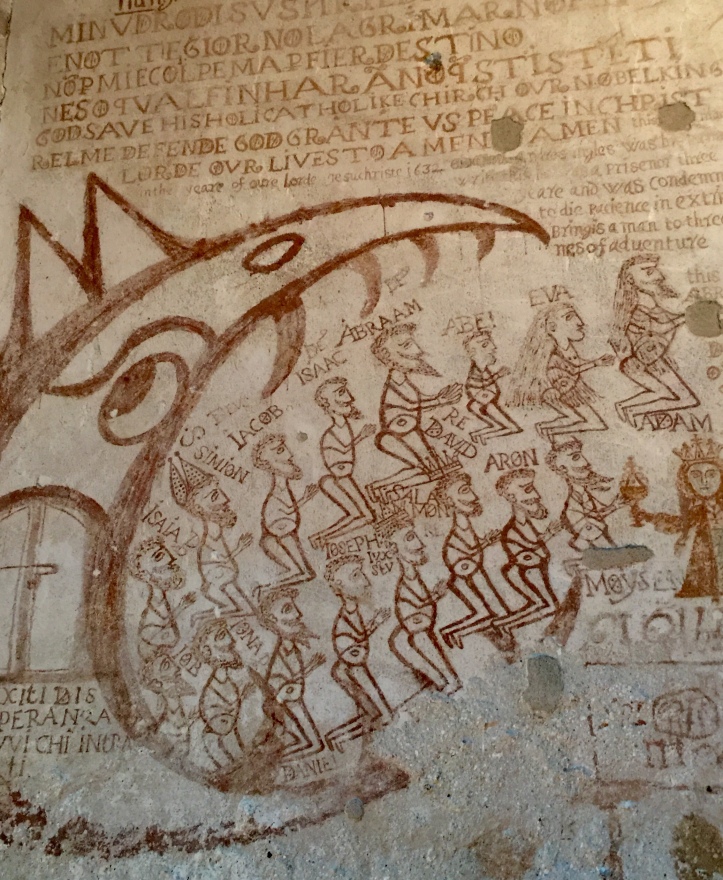
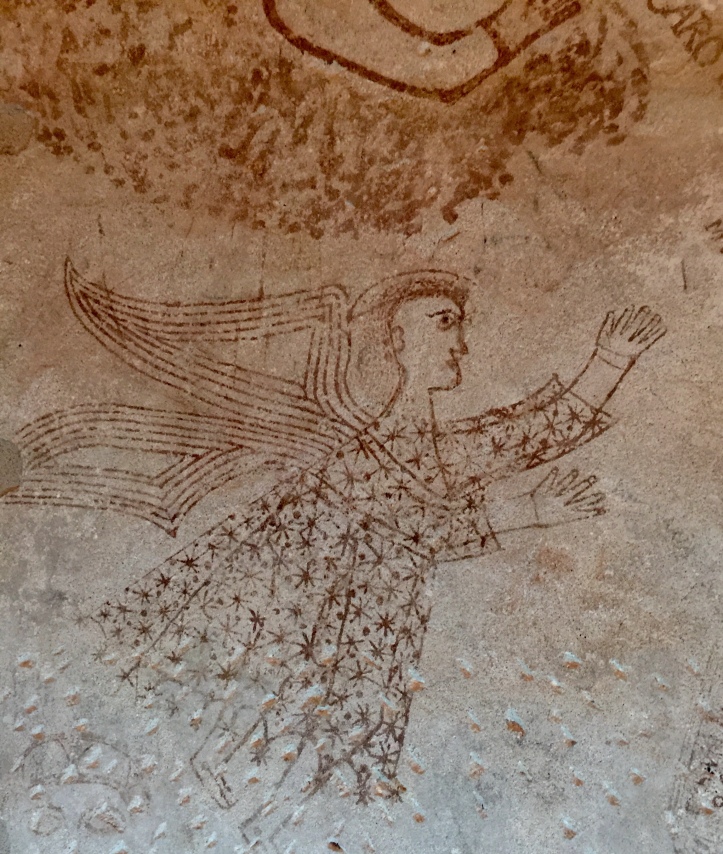 and thus deserving of freedom.
and thus deserving of freedom.
The skill of the artists is remarkable as presumably they were not trained as such, plus the fact that the paintings were executed in almost total darkness with just a small amount of candlelight to guide them.
There is definitely a Spanish look to many of the figures even when they are depicting saints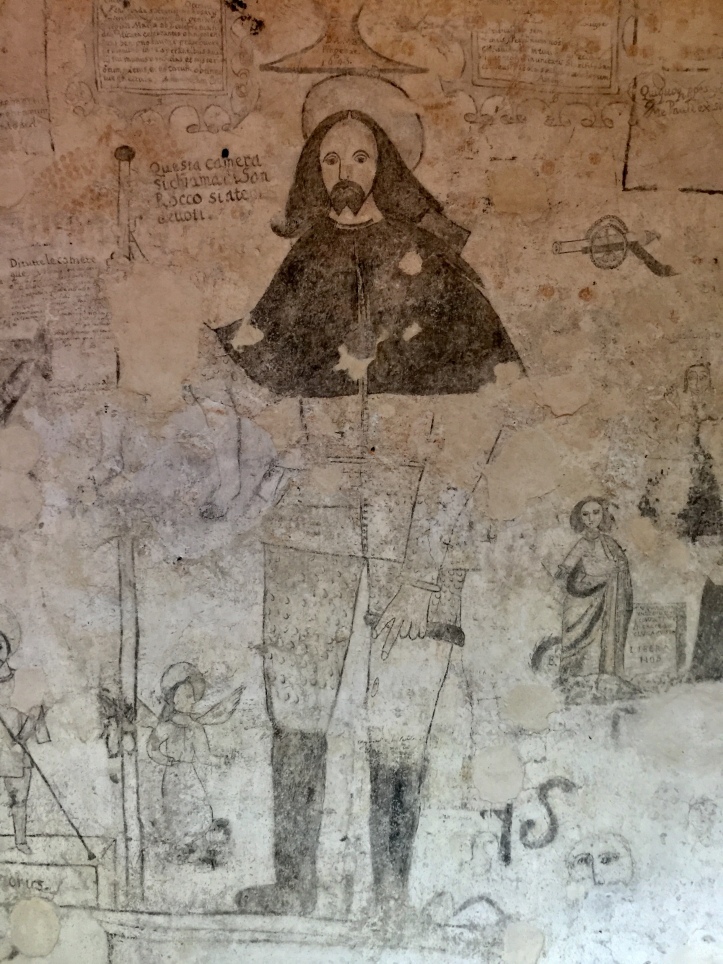

and this surely has to be referencing Ferdinand and Isabel And even in this darkest of places in the darkest of times the human spirit was able to assert itself. These cells held up to 30 men crammed into a very small space with tiny slits of windows high up on the wall, and one latrine tucked into an even smaller cavity
And even in this darkest of places in the darkest of times the human spirit was able to assert itself. These cells held up to 30 men crammed into a very small space with tiny slits of windows high up on the wall, and one latrine tucked into an even smaller cavity
 This was an area where neither guards not inquisitors ventured so the prisoners had free rein of what they painted here. Hence the cartoon like figures the top right of the toilet facility
This was an area where neither guards not inquisitors ventured so the prisoners had free rein of what they painted here. Hence the cartoon like figures the top right of the toilet facility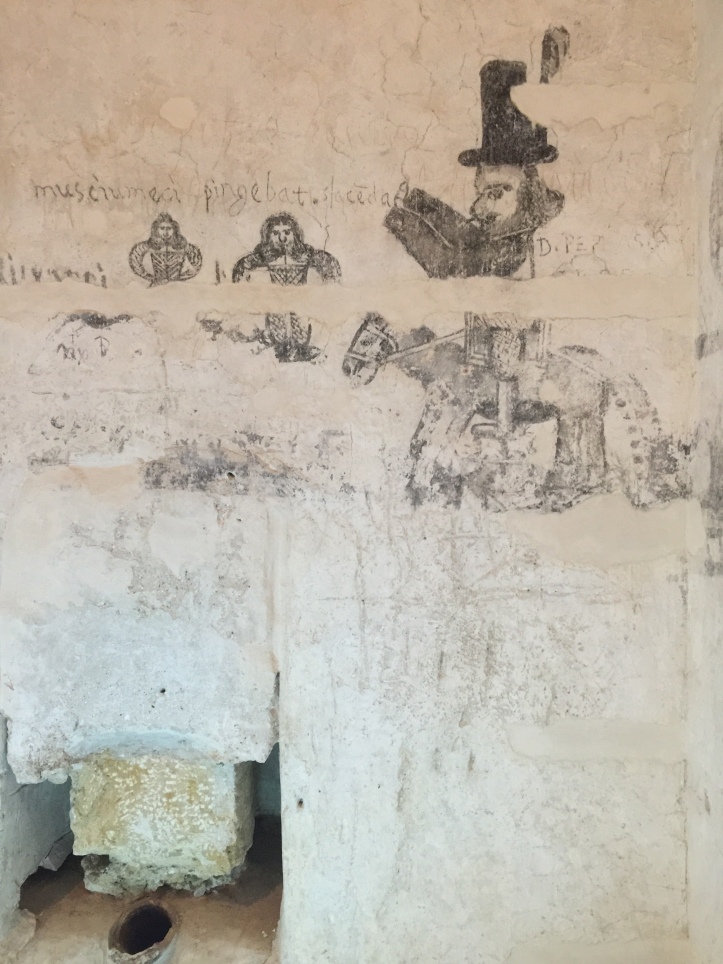 Silly hat, silly man and defecating horse!
Silly hat, silly man and defecating horse!
A really strange thing about these paintings – they reminded me strongly of the rock art I’d seen a few months ago in Arnhem Land – the colors, the practice of overpainting, the sheer skill, the significance to the individuals doing the painting …. but the similarity ends there. They are literally worlds apart in their spirituality and the sense of rightness in the art being created in that place.
When not taking guided walks or touring the Museum of the Inquisition we wandered – not aimlessly, but in a leisurely manner. We checked out all the major markets we knew of. El Capo was extremely disappointing, absolutely nothing to get excited about; Ballarò had some reasonable looking fruit and veg

 and some smelly fish, but not a patch on Asian markets or even everyday Spanish and French ones!
and some smelly fish, but not a patch on Asian markets or even everyday Spanish and French ones!
The most disappointing of all however was this one  I had been warned by the Sicilian Godmother not to expect anything too great and she was right. In 2013 she wrote
I had been warned by the Sicilian Godmother not to expect anything too great and she was right. In 2013 she wrote
the Vucciria market, founded by the North Africans over 1,000 years ago. Apart from fresh fruit and vegetables, it mainly sells specialist foods, spices and curiosities. You can buy traditional and luxury Sicilian products like Bronte pistachio pesto, sun dried tomatoes, capers, cold-worked chocolate from Modica, cinnamon liquer from Etna, and other types of unusual and luxury foods and drinks.
For one millenium it bustled with people from Palermo buying grocoeries, but over the last ten years the area has filled with immigrants from Africa and Bangladesh (among other places), who buy their food from each other’s ethnic shops. The market is much emptier than it used to be. I do hope it doesn’t just gradually fade away.
By 2015 she had conceded it was going downhill;
I was bewildered recently to find an article online, published by Italy Magazine, purporting to be about the Vucciria Market in Palermo. It described the Vucciria as a flourishing food market full of exciting fruits, vegetables and meat and fish. It said visiting the Vucciria is one of the most exciting things to do in Palermo. It had photos and everything.
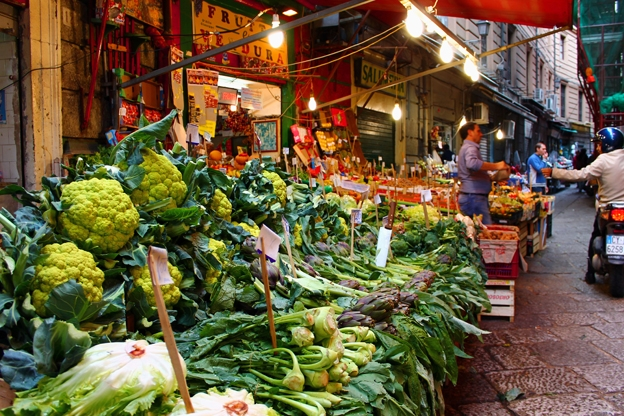 NOT the Vucciria
NOT the VucciriaThe problem is, it was not describing the Vucciria and not one of the photos was of the Vucciria!!! I am not certain where the photos were taken.
The most exciting things we found there were the Azure Bar which we tried out on our guided evening walk  and this reproduction of a famous painting of the market in its hey day hanging up behind a rather sad looking stall
and this reproduction of a famous painting of the market in its hey day hanging up behind a rather sad looking stall  I had actually read about this painting and was looking forward to viewing it, but it was apparently away from home in a touring exhibition, so I guess I was lucky to see this!
I had actually read about this painting and was looking forward to viewing it, but it was apparently away from home in a touring exhibition, so I guess I was lucky to see this!
As well as all the luscious fruit and vegetables the artist, Renato Guttoso, painted in his luscious lover (the lady with her back to the viewer) and two self portraits, his current older self in the background on the left and the younger man in the brown jacket. So there you go!
I seem to have reached my limit for uploading on this post, so will bid you good night at this point and finish off with a few random photos tomorrow.